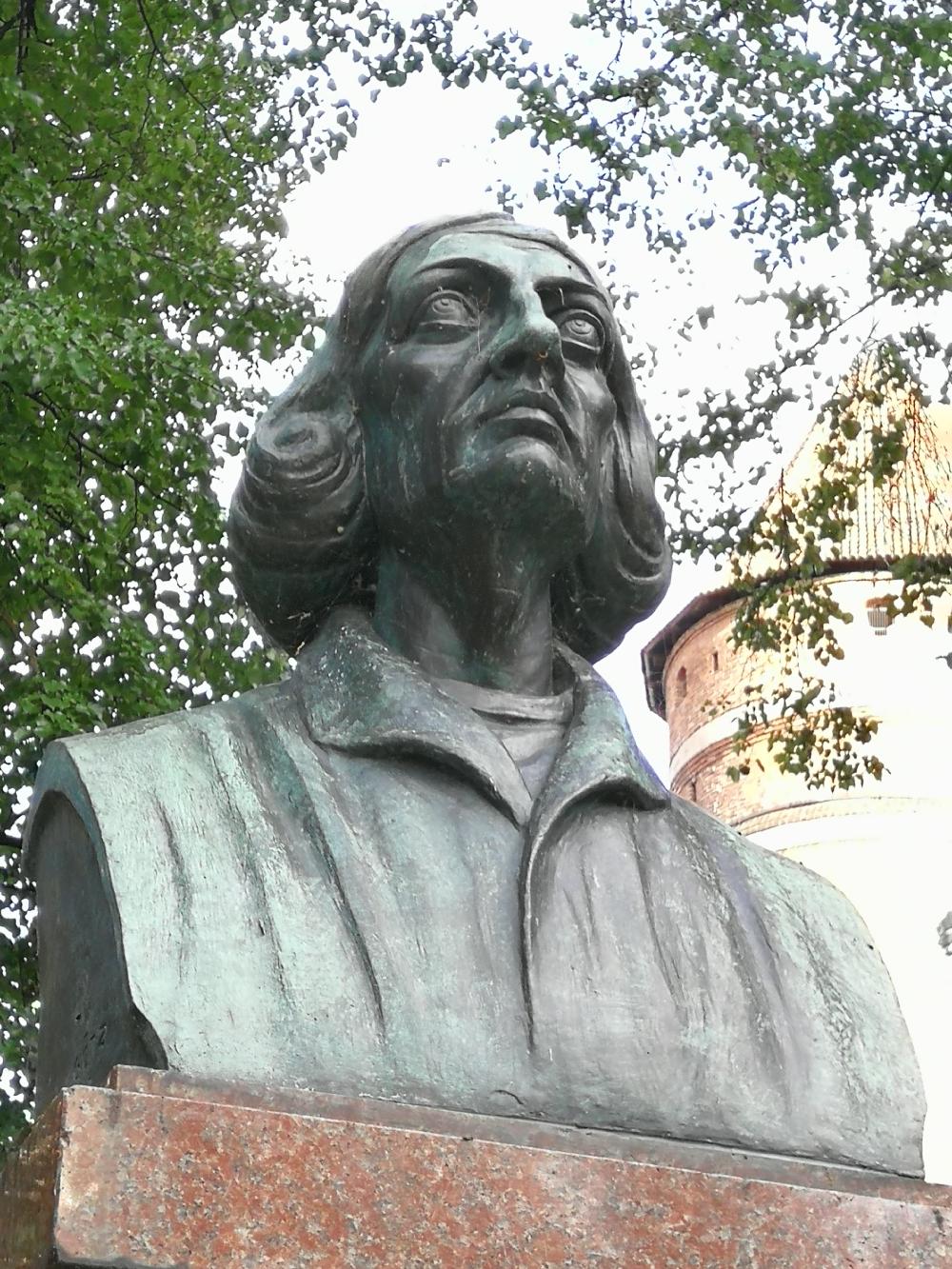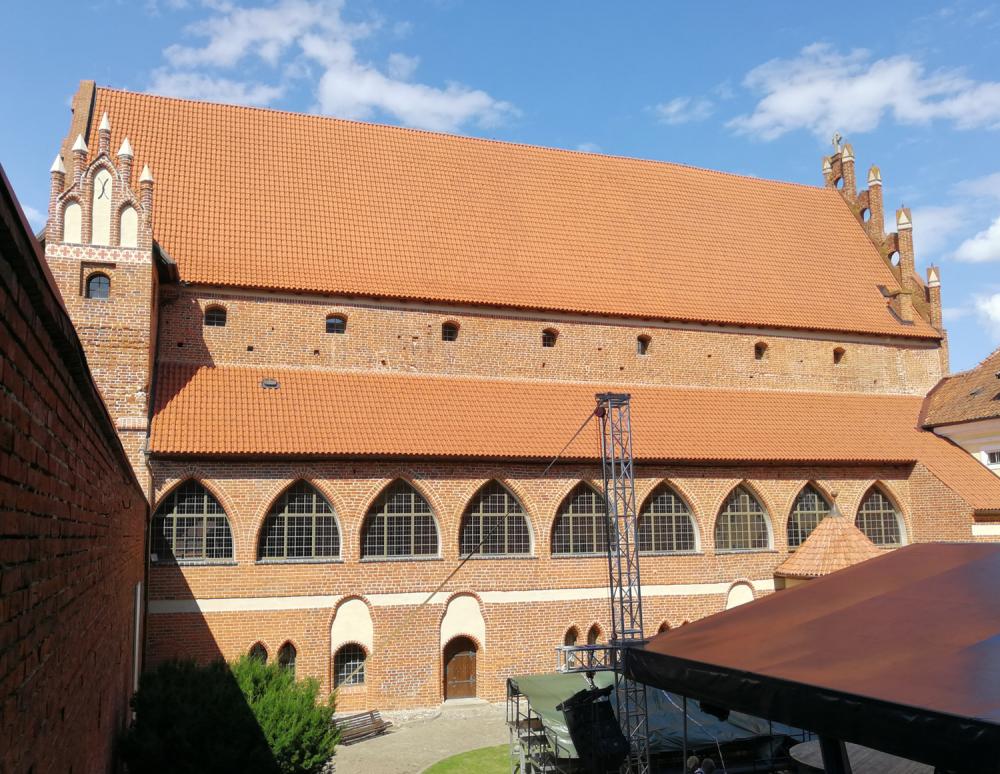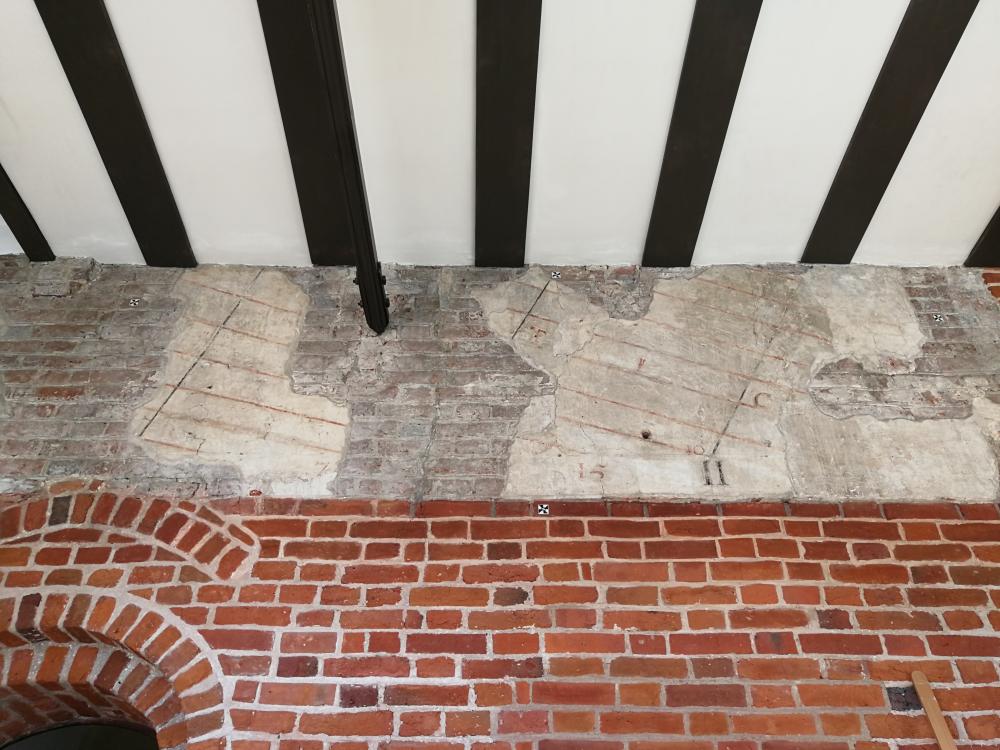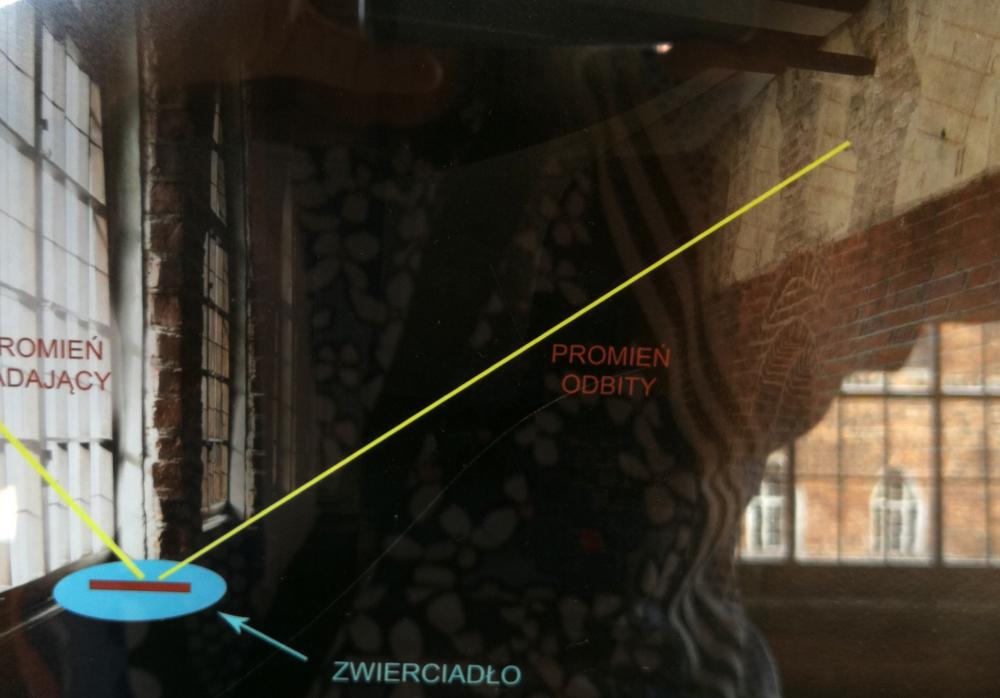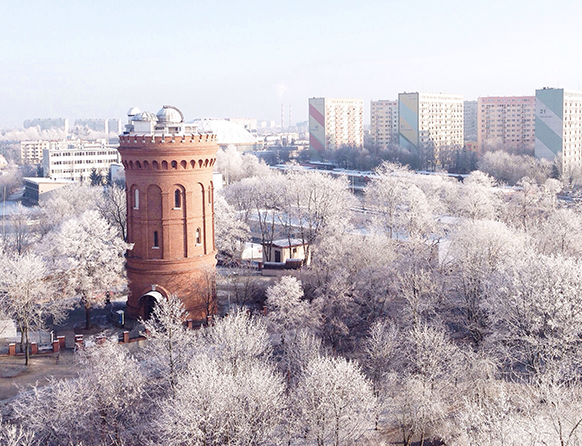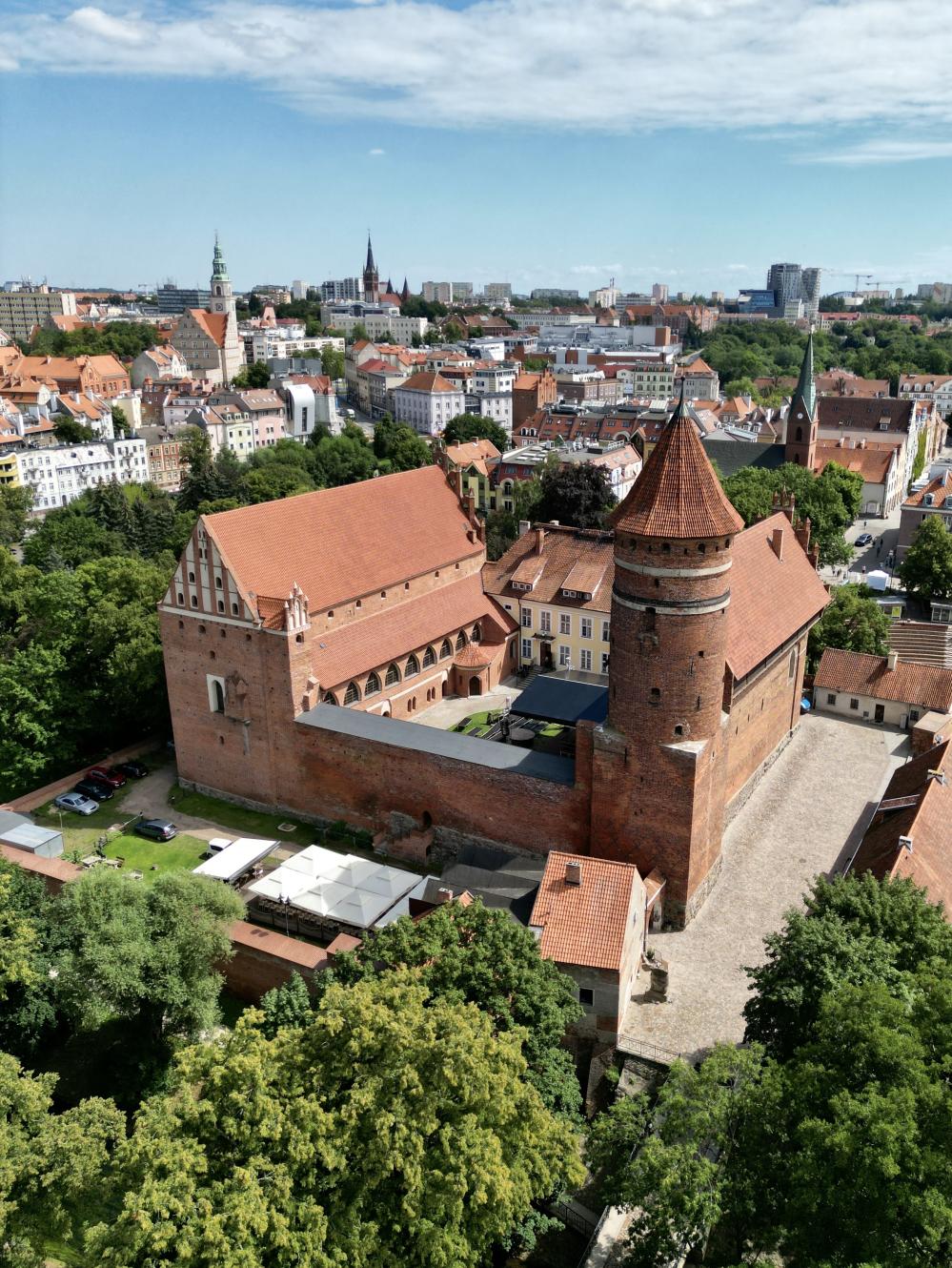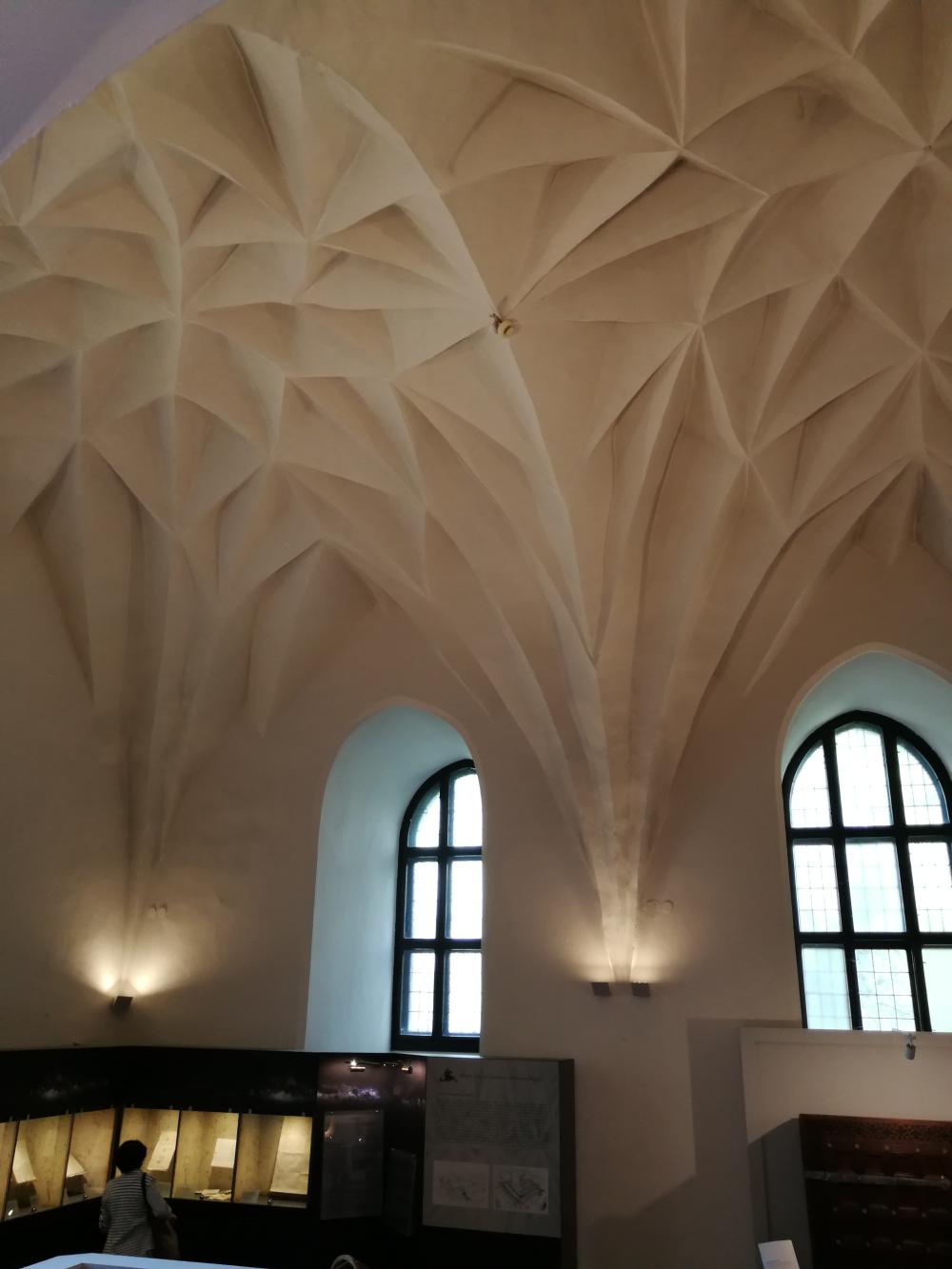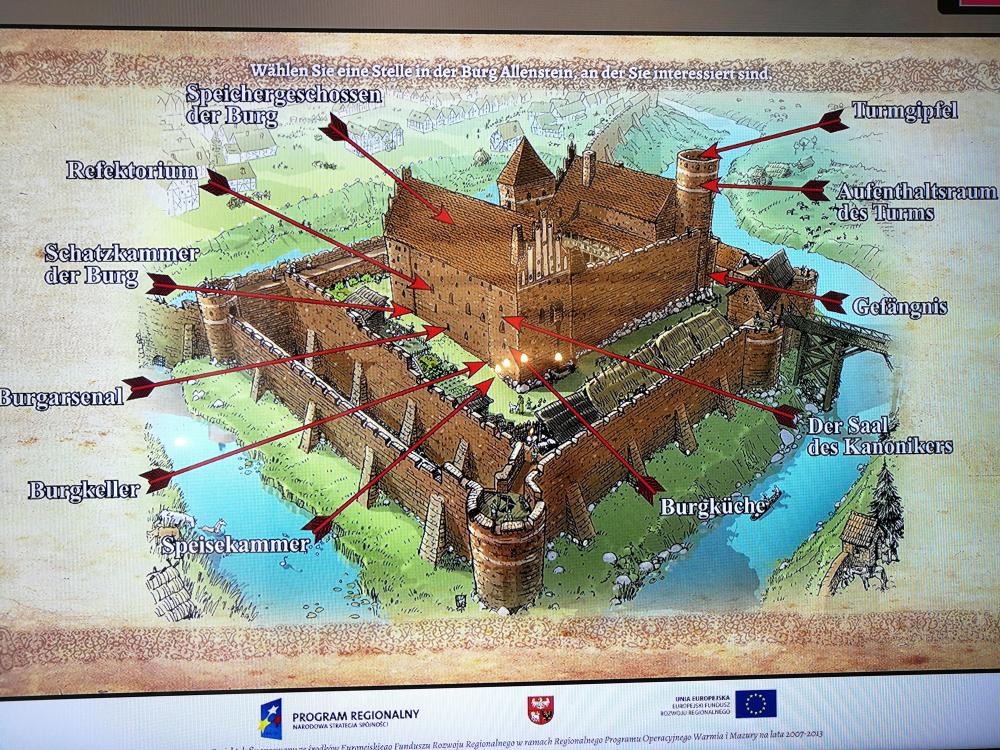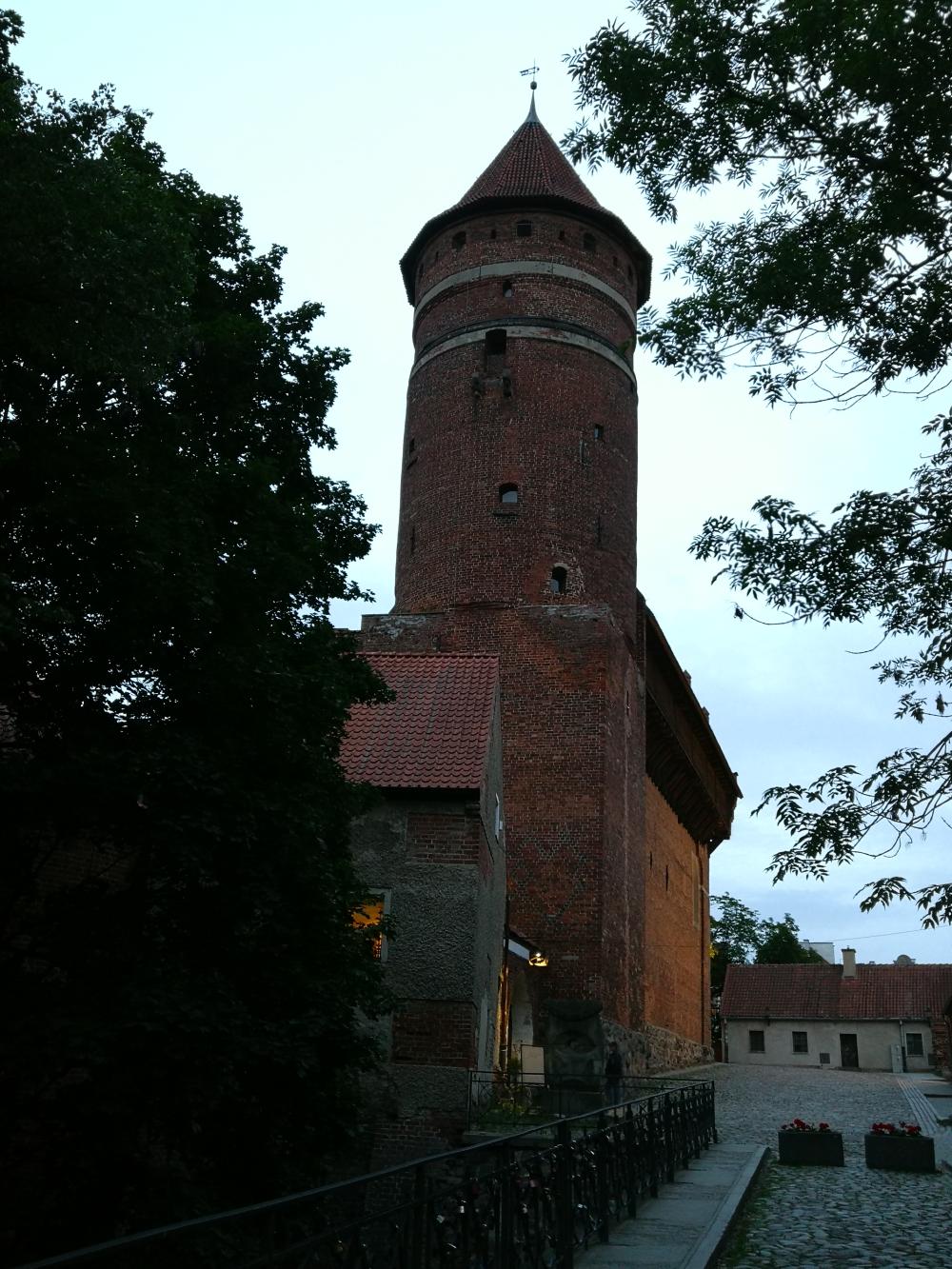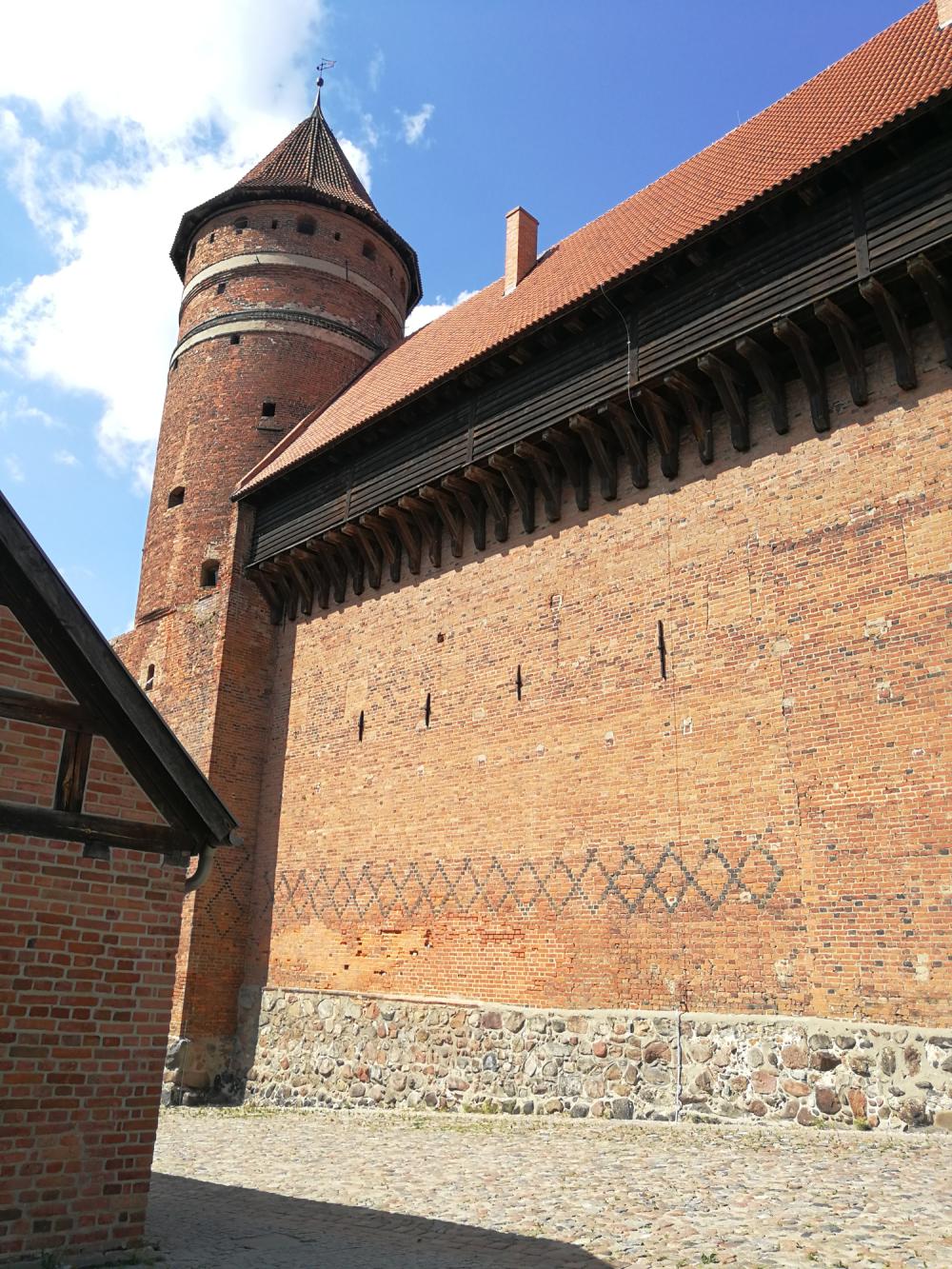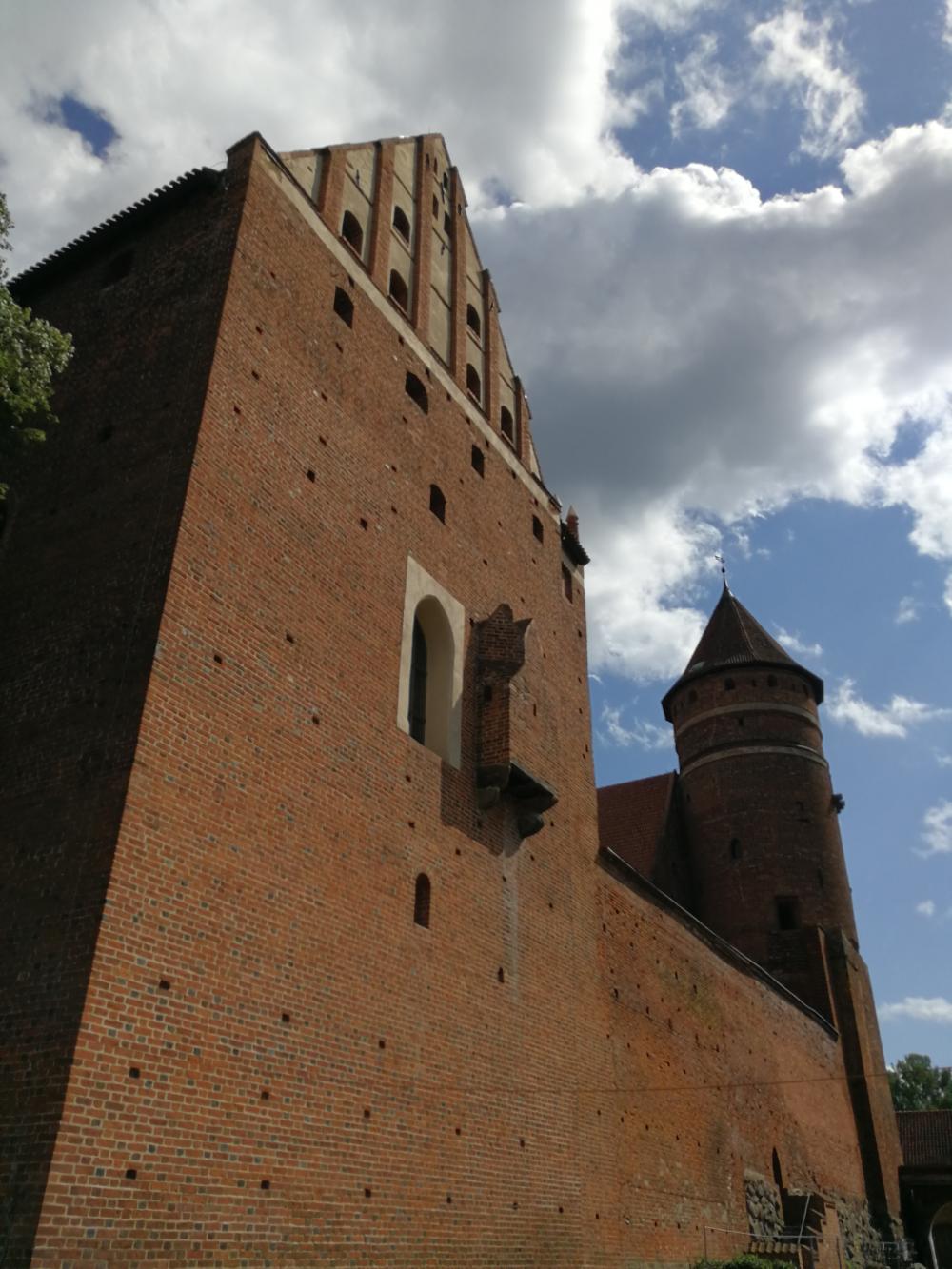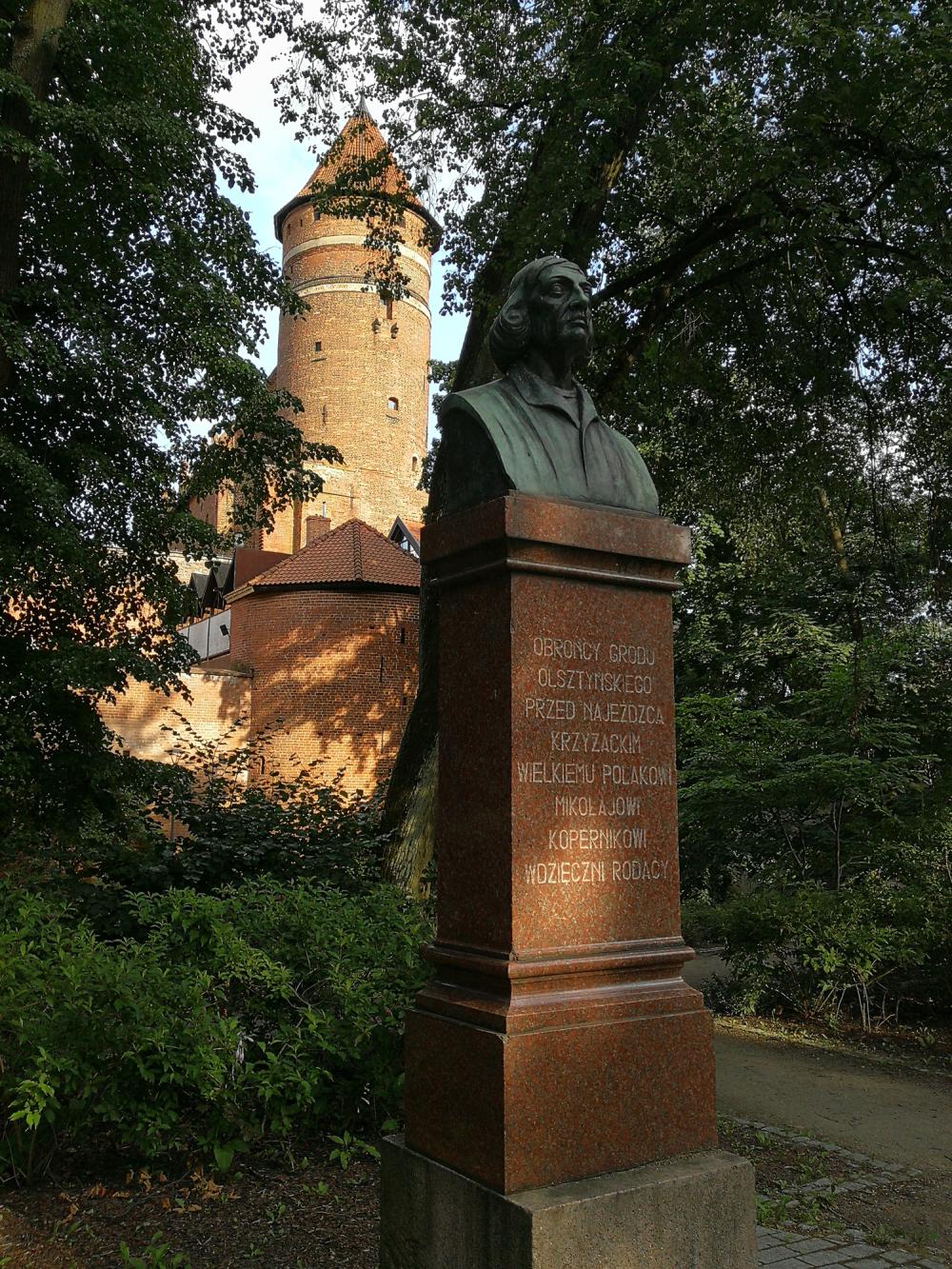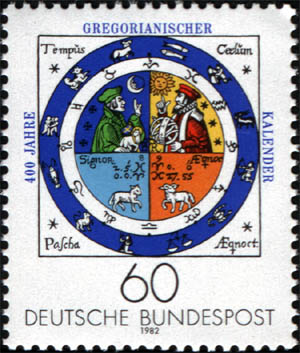
Category of Astronomical Heritage: tangible immovable
Heliograph (Astronomical Table), Olsztyn/Allenstein Castle, Poland

Description
Geographical position
Heliograph (Astronomical Table), Olsztyn/Allenstein Castle, Poland
More places connected to Copernicus:
- Collegium Maius at the time of Copernicus, Jagiellonian University, Kraków/Cracow, Poland
- Heliograph (Astronomical Table), Olsztyn/Allenstein Castle, Poland
- Copernicus observing site in Frauenburg / Frombork, Poland
Location
Latitude 53°46' N, Longitude 20°28' E, Elevation ...m above mean sea level.
IAU observatory code
-
Description of (scientific/cultural/natural) heritage
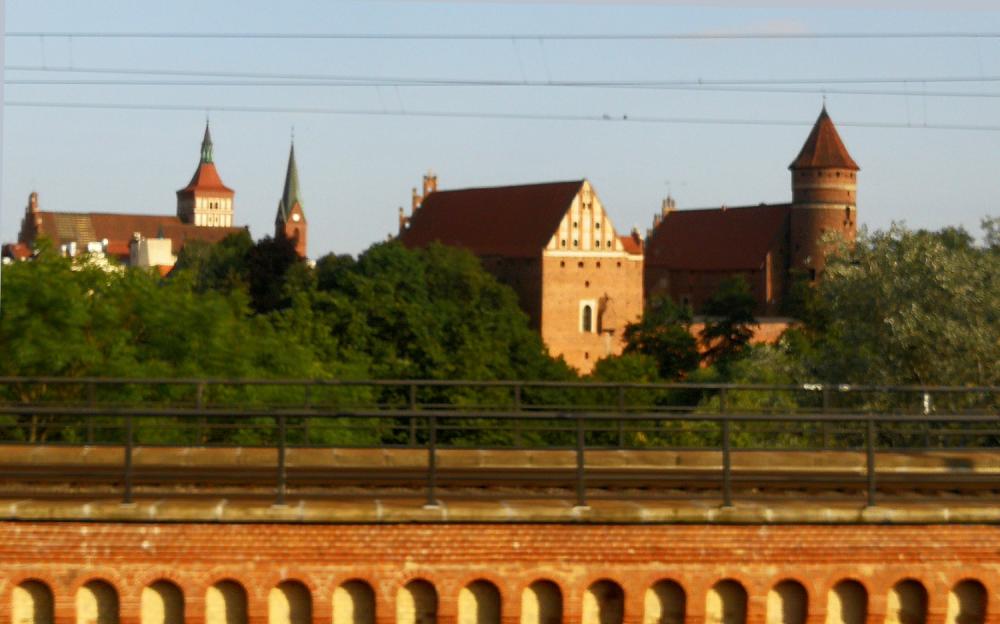
Fig. 1. Castle Allenstein/Olsztyn with the keep (Photo: Gudrun Wolfschmidt)
The Castle of the Warmian Cathedral Chapter in Olsztyn/Allenstein (Zamek Kapituły Warmińskiej w Olsztynie), built in brick Gothic (1346--1353) by the Teutonic Order. The castle keep was erected at the end of the 14th century.
Casimir IV Jagiellon (1427--1492), King of Poland from 1447 until 1492, incorporated the region after the Thirteen Years' War (1454--1466) to the Polish Crown, confirmed by the Second Peace of Thorn/Toruń in 1466. Then the castle belonged to the chapter of the Diocese of Warmia.
The market square in Olsztyn is part of the European Route of Brick Gothic.
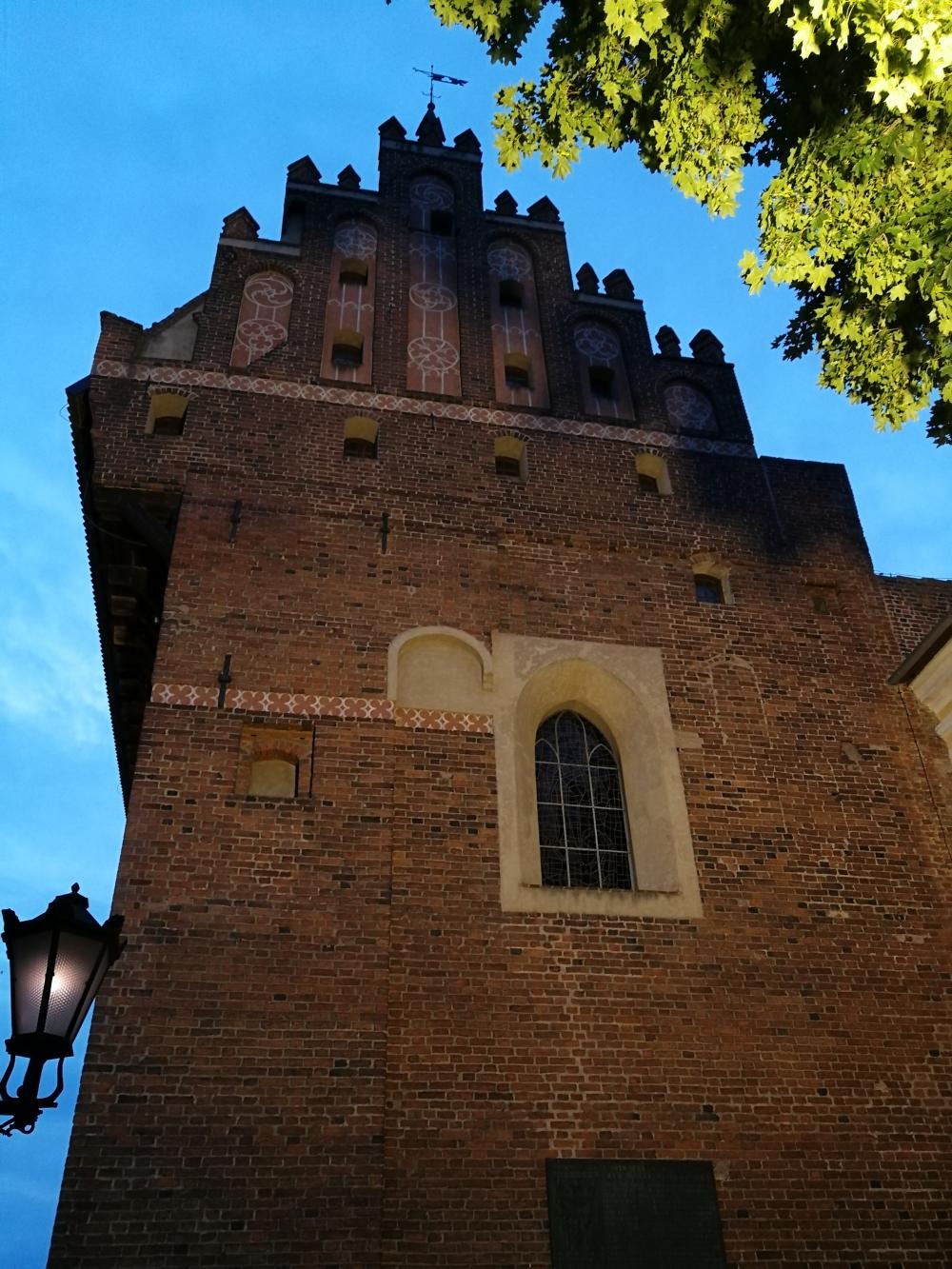
Fig. 2a. Castle Allenstein/Olsztyn (Photo: Gudrun Wolfschmidt)

Fig. 2b. Castle Allenstein/Olsztyn (Photo: Gudrun Wolfschmidt)

Fig. 2c. Castle Allenstein/Olsztyn (Photo: Gudrun Wolfschmidt)
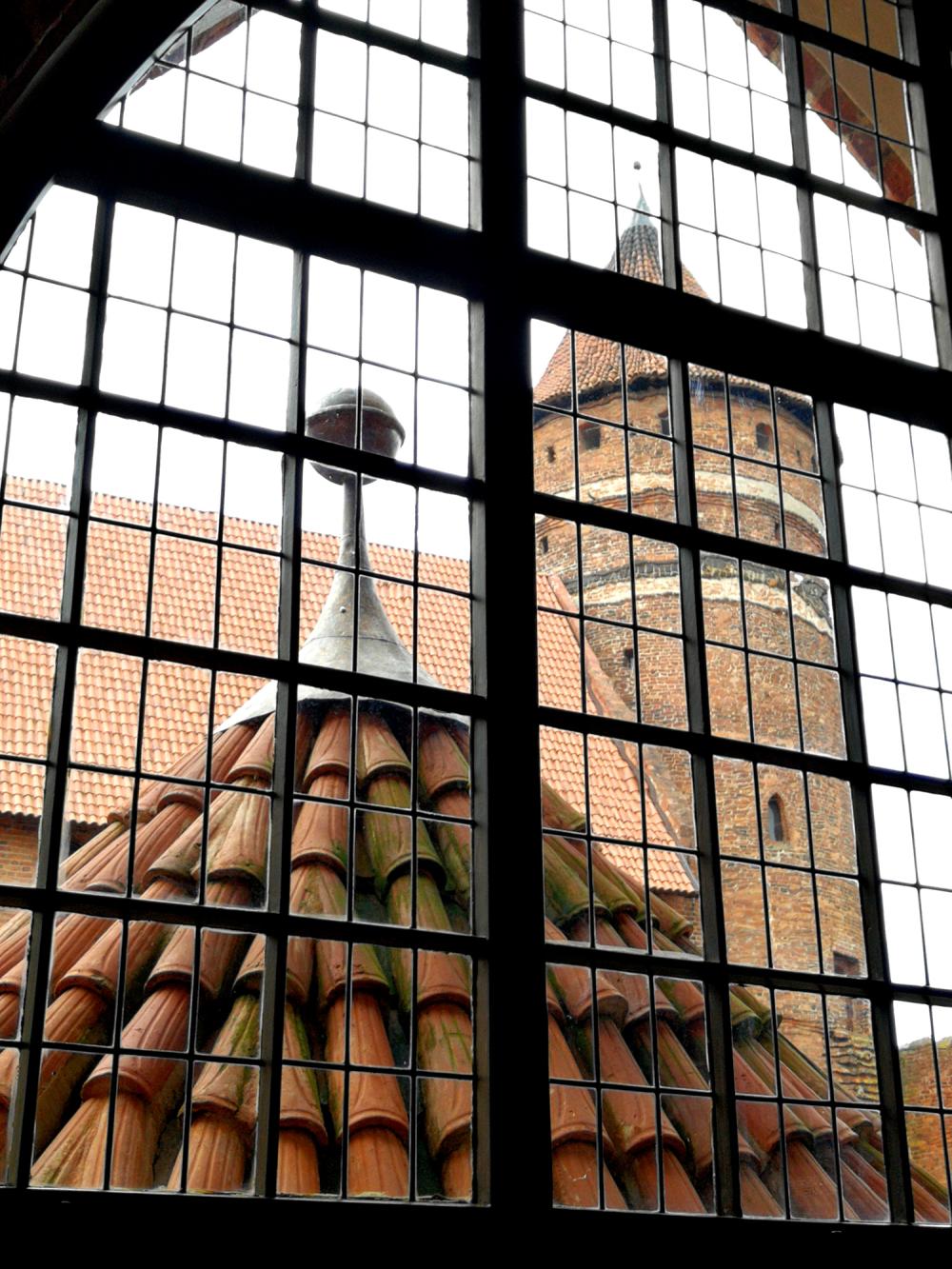
Fig. 2d. Castle Allenstein/Olsztyn (Photo: Gudrun Wolfschmidt)
Nicolaus Copernicus stayed in Olsztyn (Allenstein) Castle in the Bishopric of Warmia from 1516 to 1521 and 1523. In the castle of Olsztyn, we find Copernicus' study with his desk and library cabinet. The diamond vault in the refectory of the castle was built around 1520.
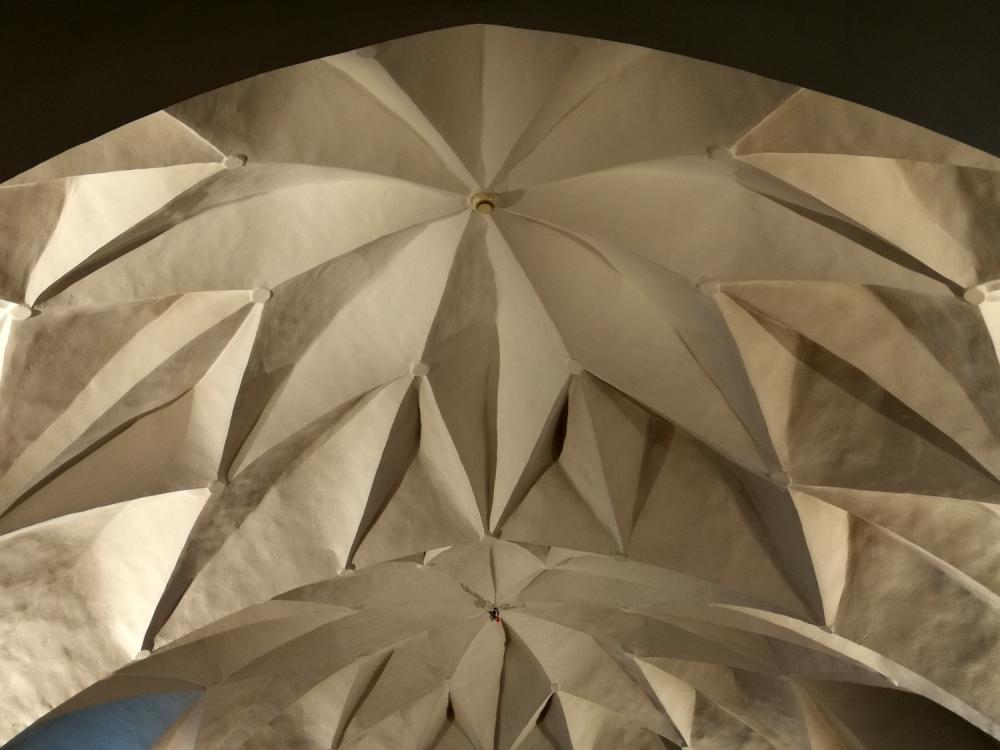
Fig. 3a. Diamond Vaults of the Gothic Hall in Castle Allenstein/Olsztyn (Photo: Gudrun Wolfschmidt)
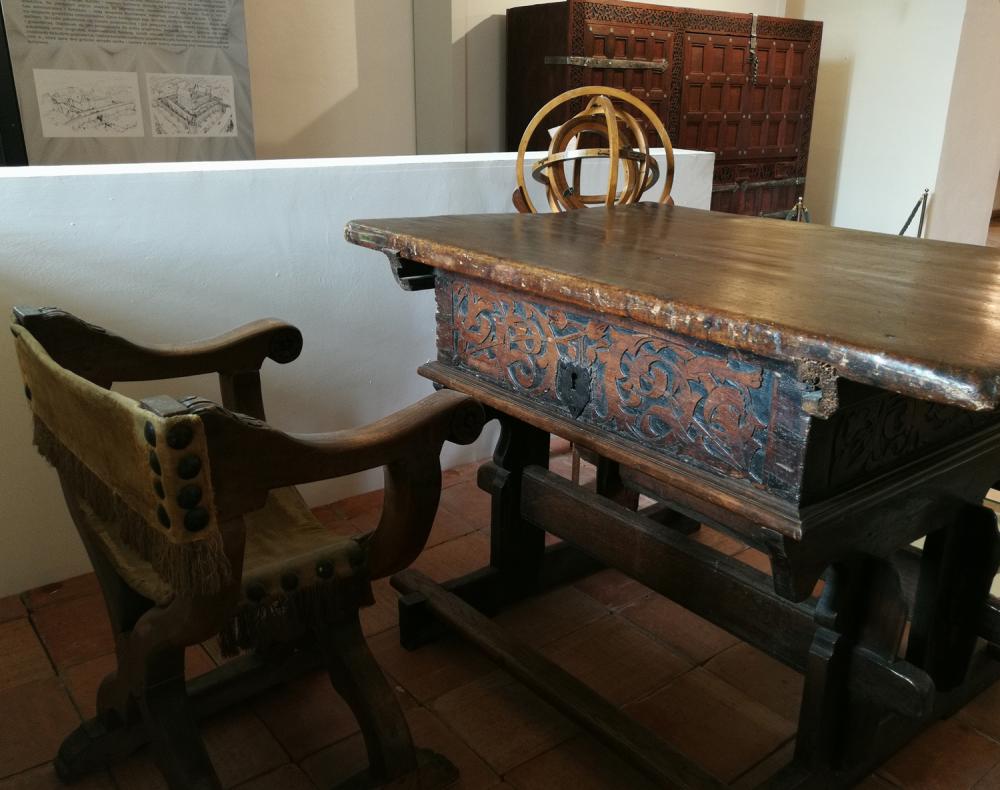
Fig. 3b. Copernicus study in the Gothic Hall in Castle Allenstein/Olsztyn (Photo: Gudrun Wolfschmidt)
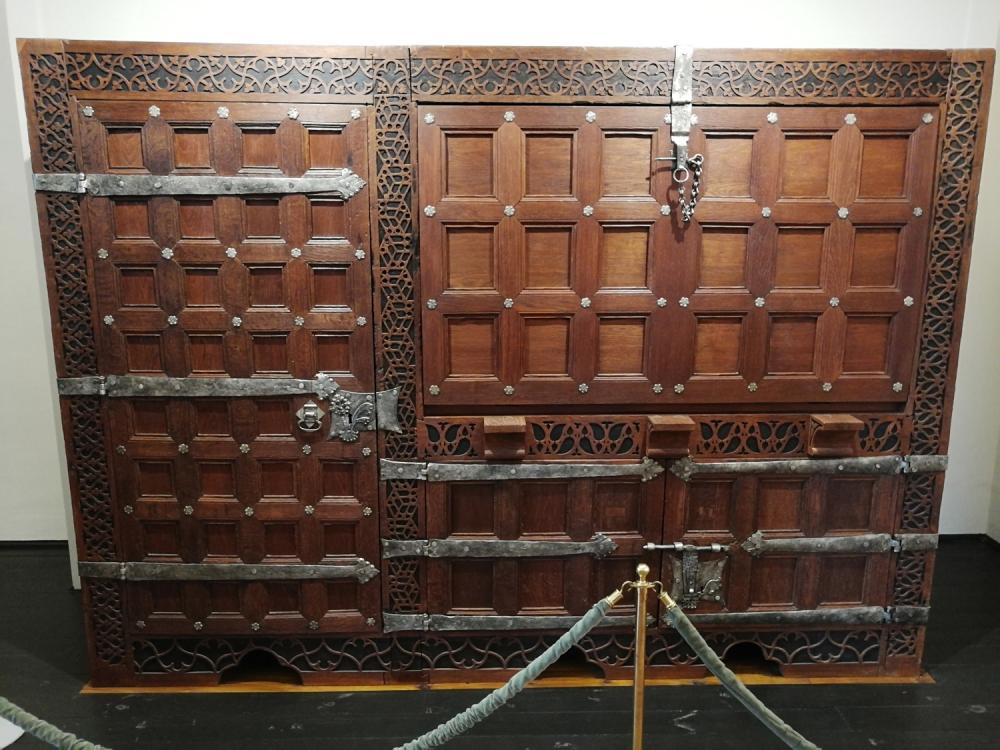
Fig. 3c. Copernicus study with library cabinet in the Castle Allenstein/Olsztyn (Photo: Gudrun Wolfschmidt)
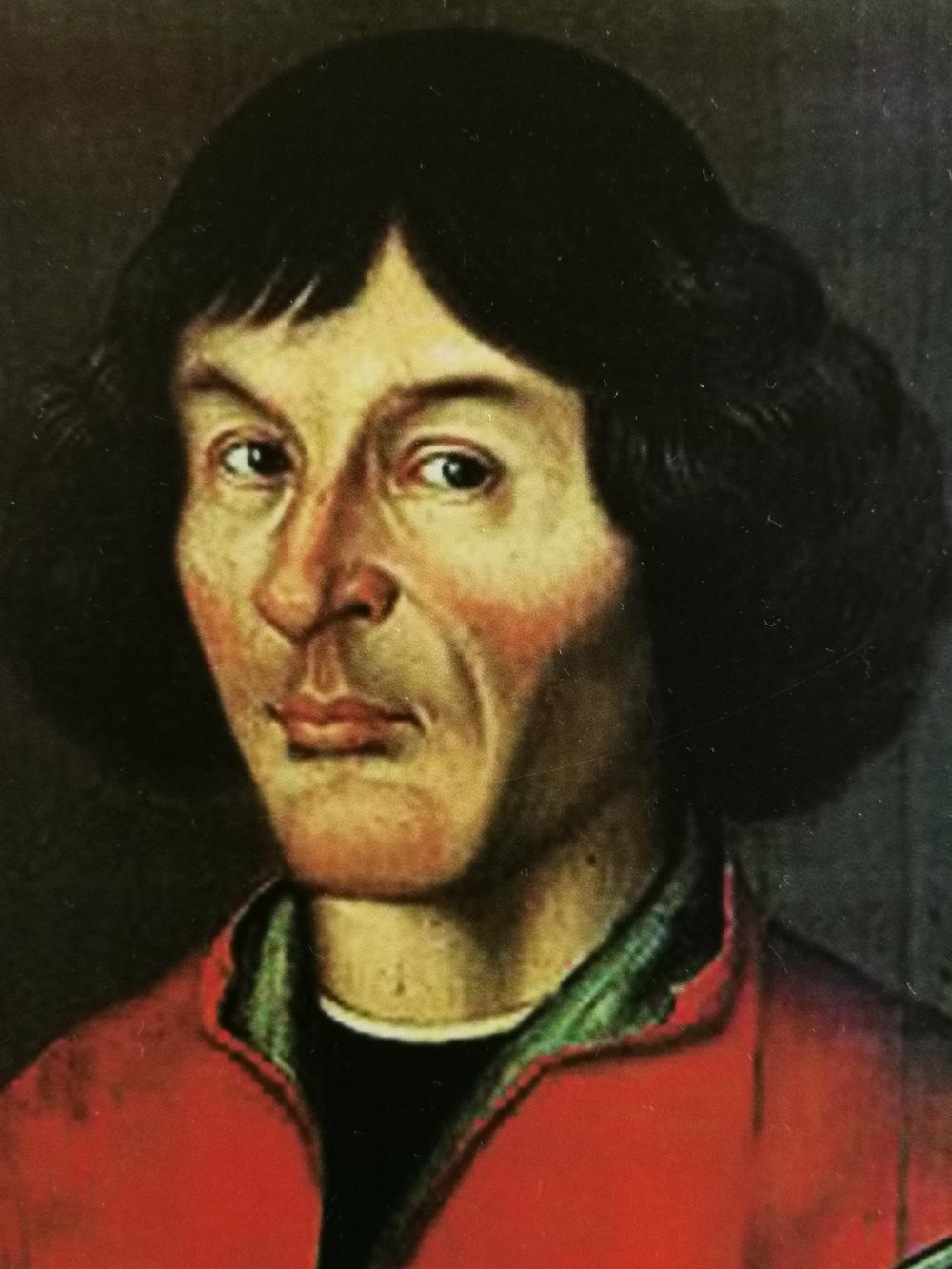
Fig. 3d. Copernicus in the Castle Allenstein/Olsztyn (Photo: Gudrun Wolfschmidt)
Copernicus may have used the castle towers of Allenstein (Olsztyn) for astronomical observations.
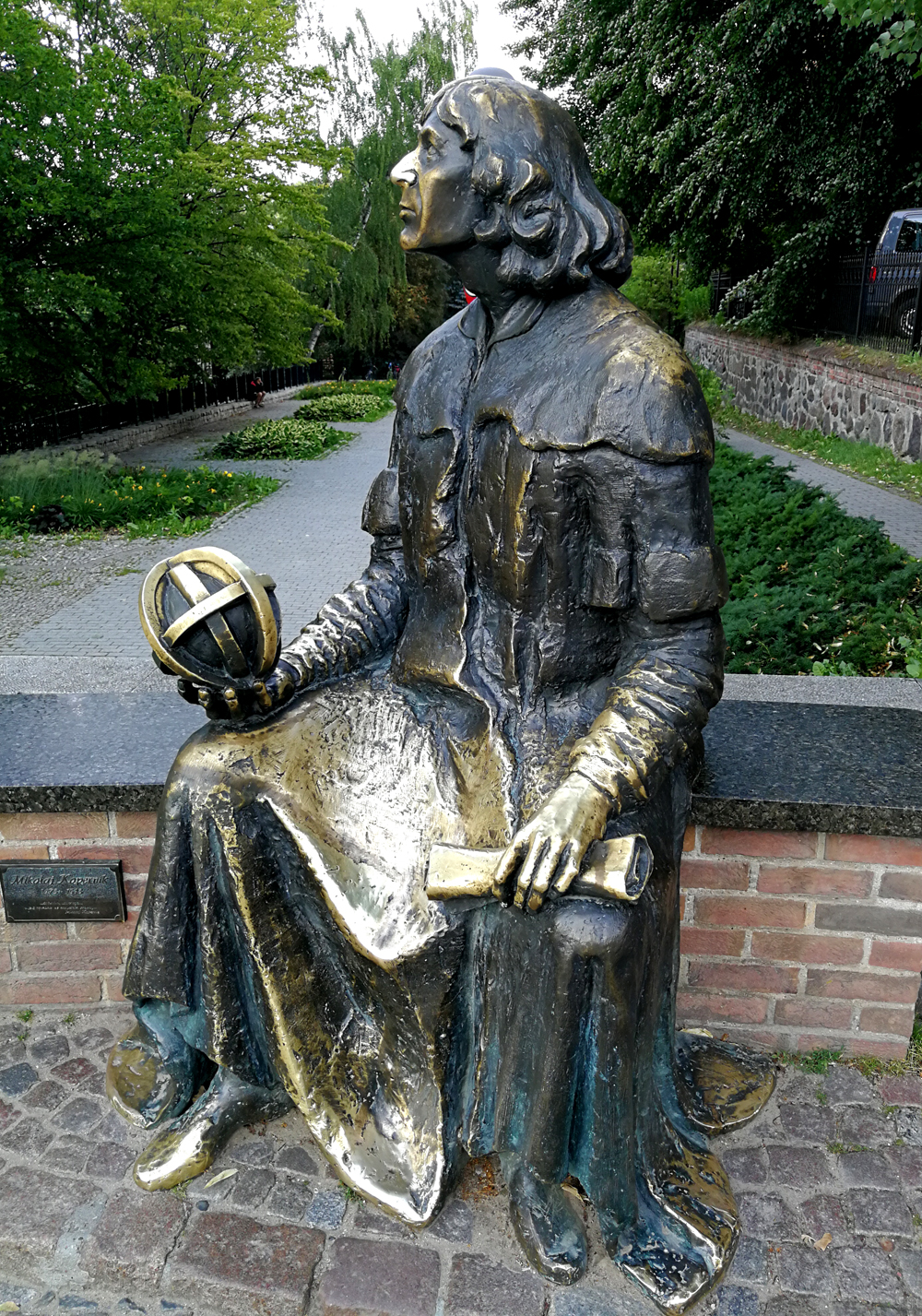
Fig. 4a. Copernicus statue with armillary sphere near Castle Allenstein/Olsztyn (Photo: Gudrun Wolfschmidt)
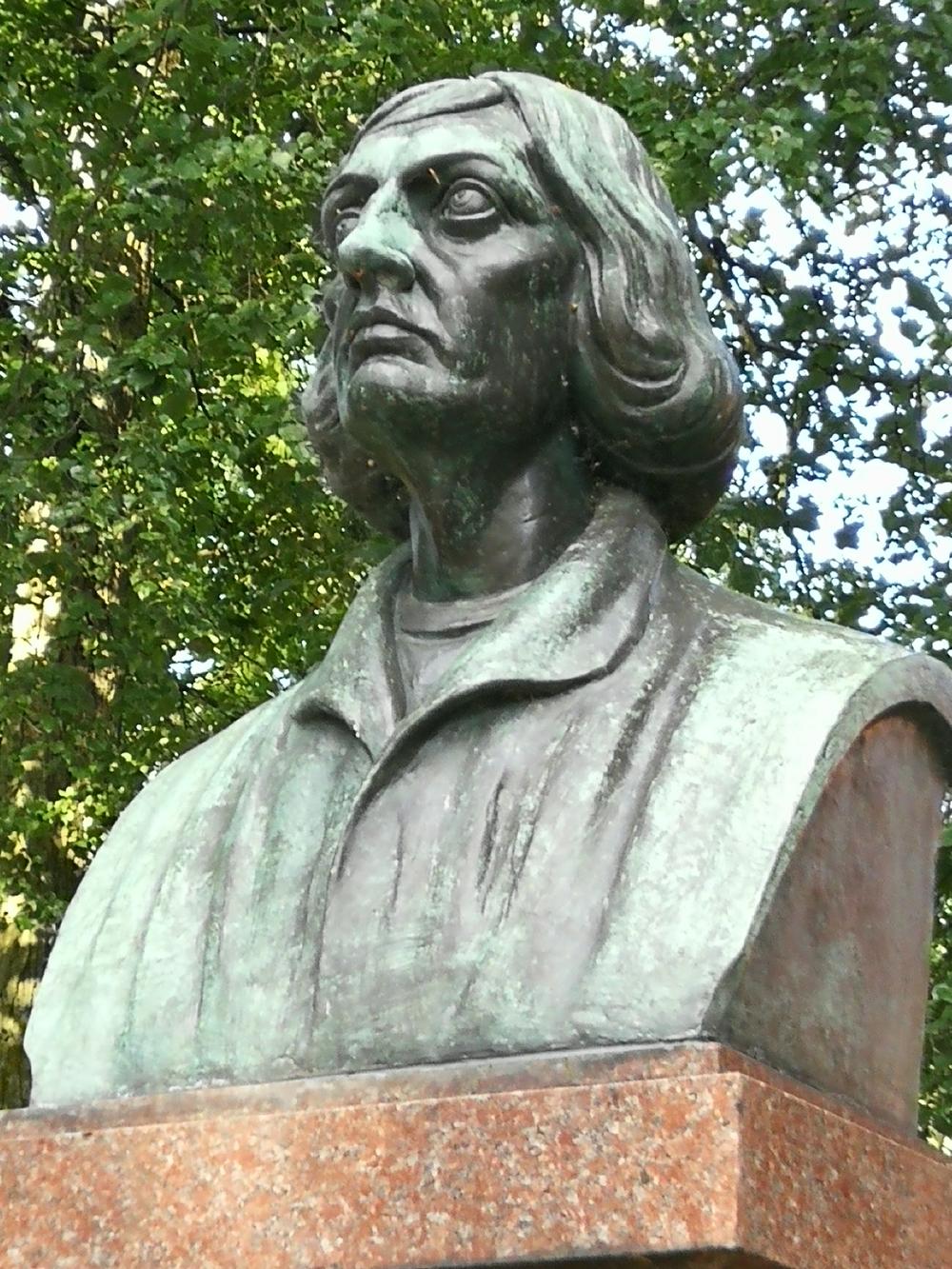
Fig. 4b. Copernicus statue near Castle Allenstein/Olsztyn (Photo: Gudrun Wolfschmidt)
Copernicus Statues
A Copernicus statue with armillary sphere (2003) can be found in front of the castle Olsztyn. The quotation is taken from the unauthorised preface of the Lutherian cleric Andreas Osiander in Nuremberg in Copernicus’ De revolutionibus:The endeavour of scholars is to find the truth in all things.
Another Copernicus statue is behind the Castle Olsztyn:To the defender of the city of Olsztyn against Teutonic Knights,
to the great Pole -- Nicolaus Copernicus --
from grateful fellow-countrymen.
History
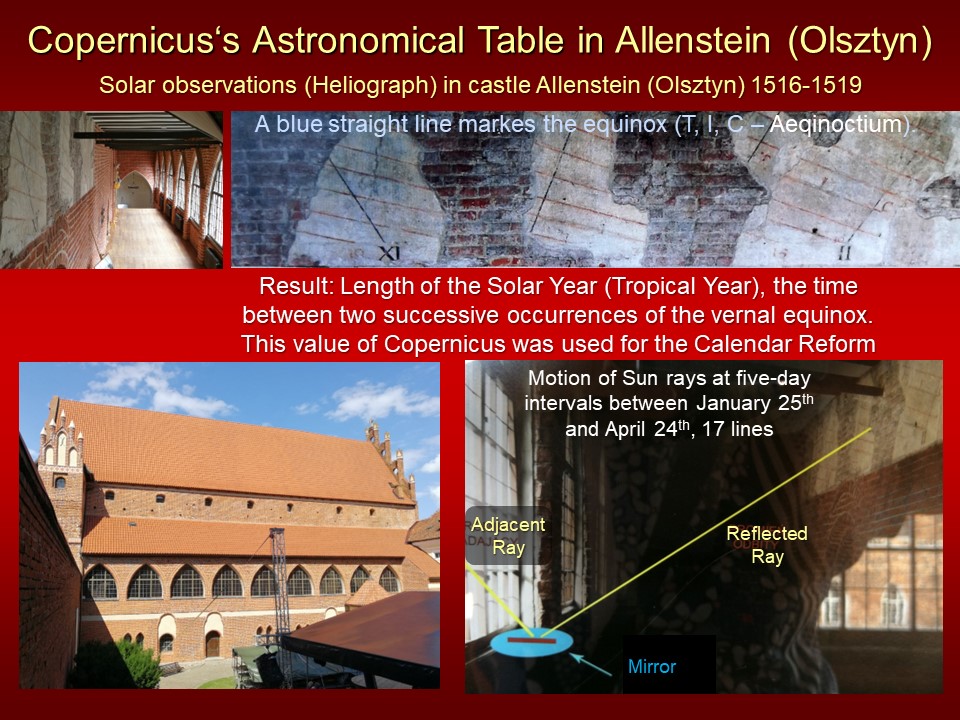
Fig. 5. Heliograph (Copernicus’ Astronomical Table), 1516--1519, in Castle Allenstein/Olsztyn (Photo: Gudrun Wolfschmidt)
Instrument
- Heliograph (Tablica astronomiczna, Copernicus’ Astronomical Table, "Solar dial"), 1516--1519
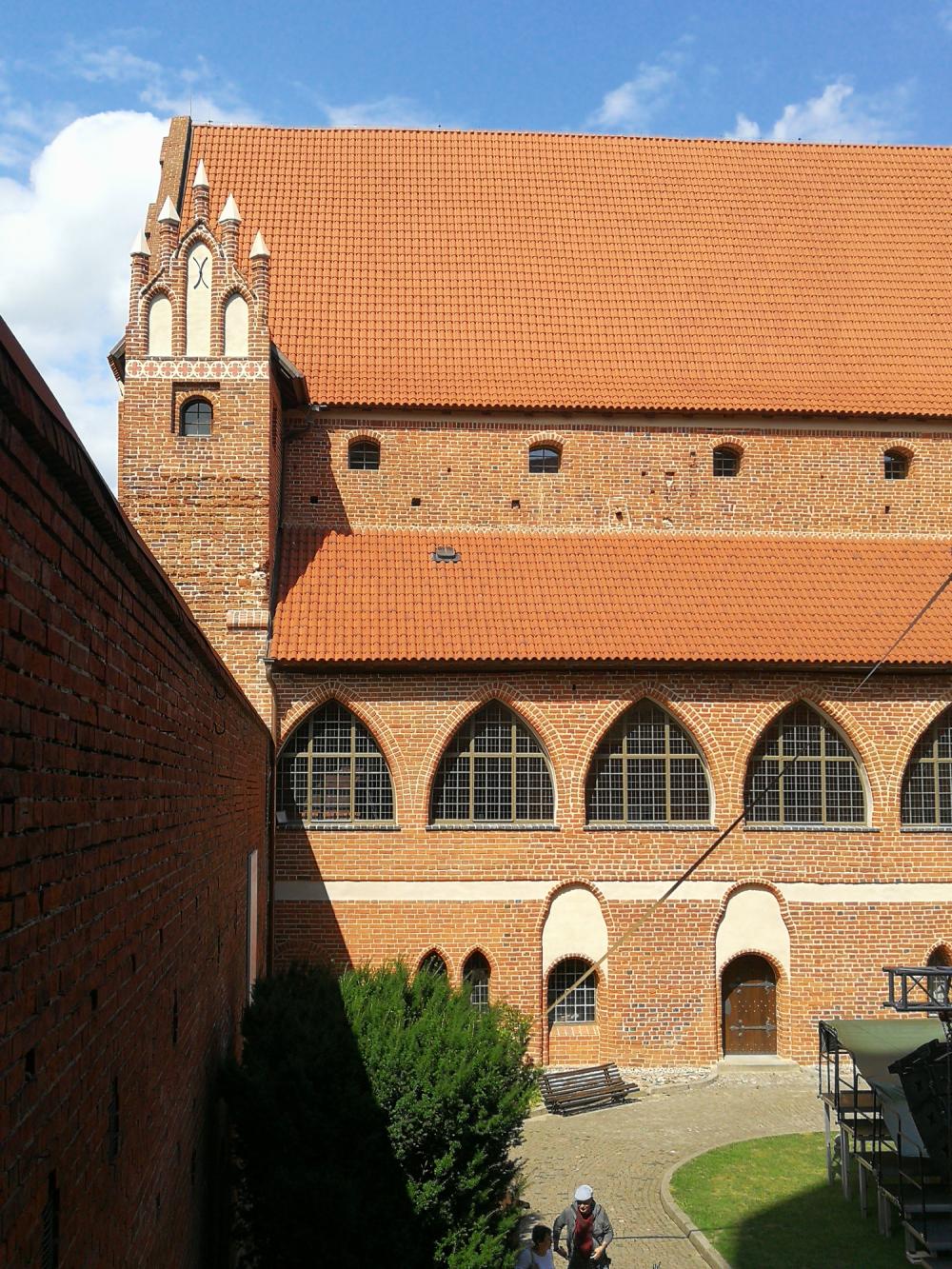
Fig. 6a. Heliograph (Copernicus’ Astronomical Table), 1516--1519, in Castle Allenstein/Olsztyn; the Sun rays enter in the third window from the left (Photo: Gudrun Wolfschmidt)
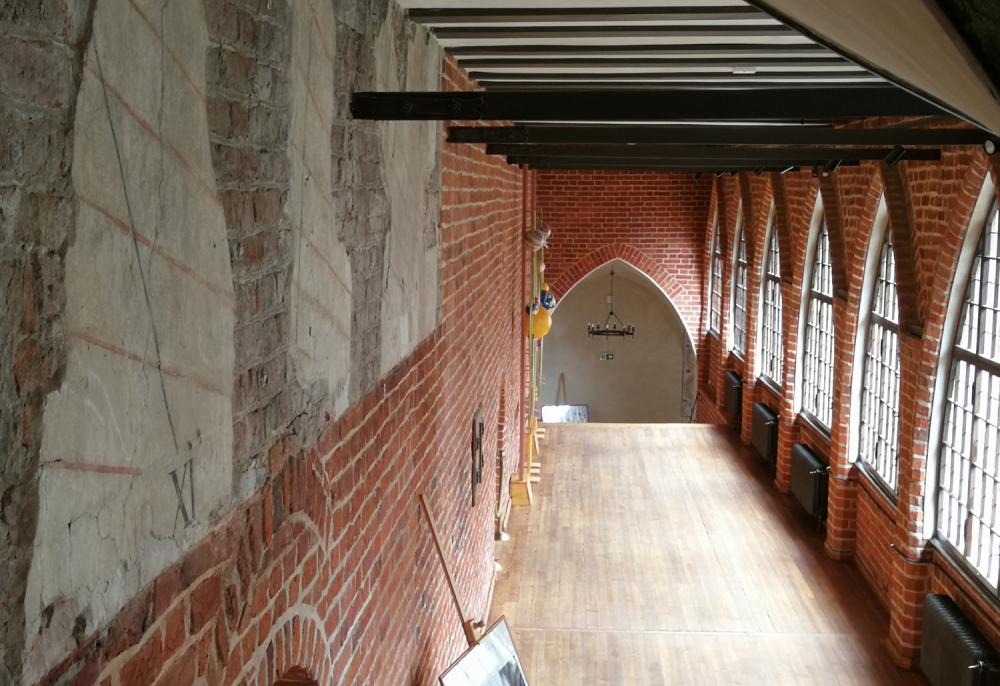
Fig. 6b. The gallery with the Heliograph (Copernicus’ Astronomical Table) on the left side, in Castle Allenstein/Olsztyn (Photo: Gudrun Wolfschmidt)
Copernicus was requested by the V. Lateran Council to collaborate in the Calendar Reform (1514).
A highlight in this context is the Heliograph (Tablica astronomiczna, Copernicus’ Table). This design has been regarded as some kind of vertical sundial.
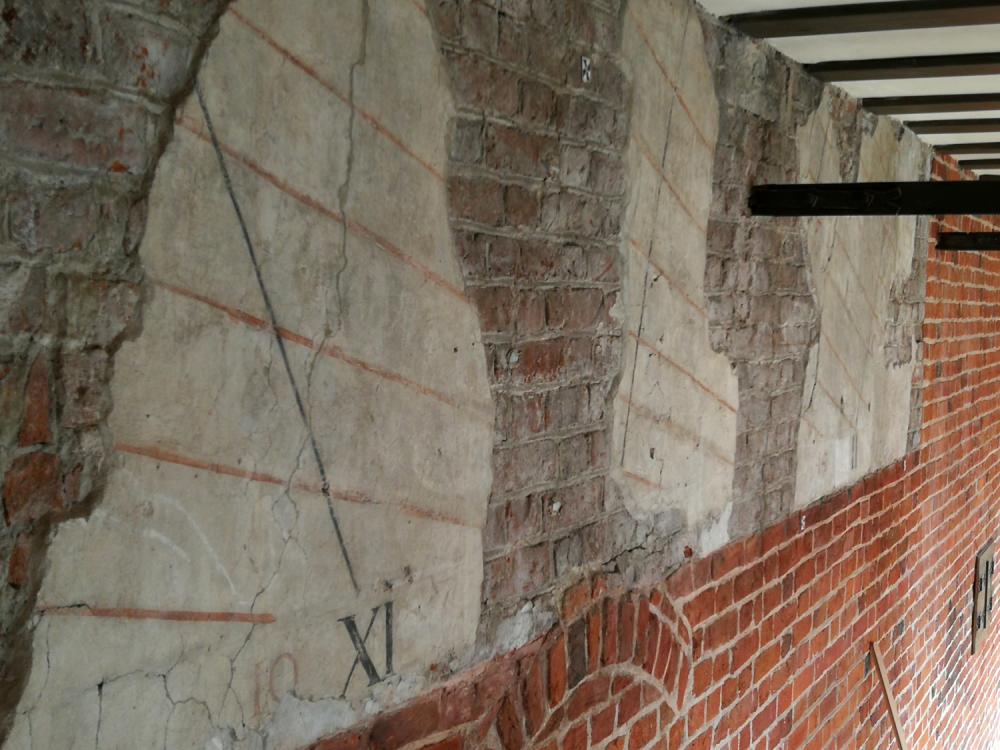
Fig. 7a. Heliograph (Copernicus’ Astronomical Table), 1516--1519, in Castle Allenstein/Olsztyn (Photo: Gudrun Wolfschmidt)
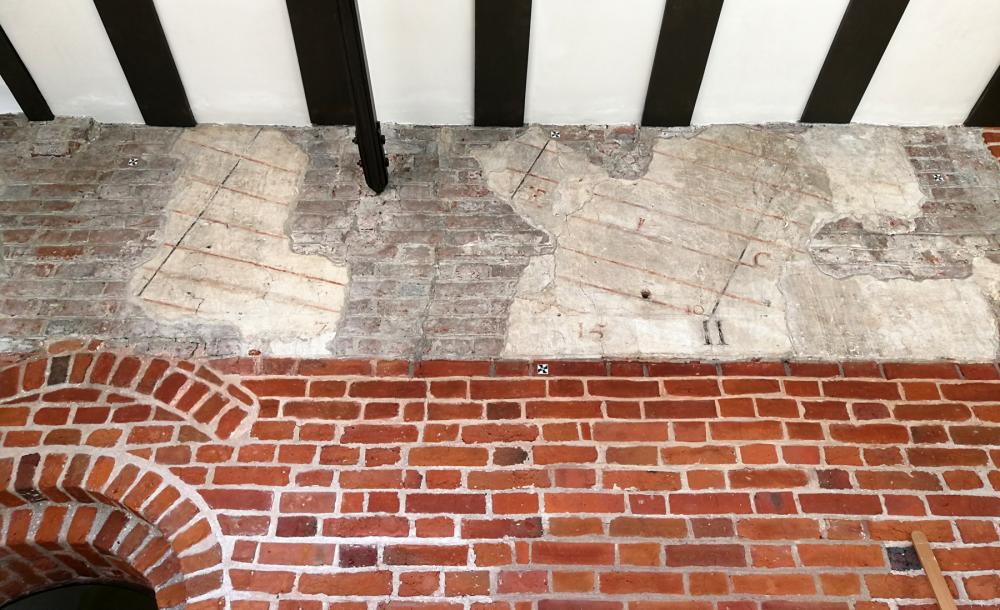
Fig. 7b. Heliograph (Copernicus’ Astronomical Table) in Castle Allenstein/Olsztyn (Photo: Gudrun Wolfschmidt)
Copernicus had "keen interest in observations of the equinoxes led him to set up a novel type of observatory at the interior hallway at the north side of the castle of Olsztyn.’’ (Graßhoff & Fischer 2017). With this instrument he wanted to observe the annual path of the Sun through the equinoxes.
This scientific instrument (1517) is engraved in the wall in the castle of the Warmia Chapter in Allenstein/Olsztyn in Poland above the entrance to his private apartments. The scratching of the lines into the wall is still to be recognized -- inspite of some damages.
The measuring lines are only partly preserved, repainted and walls were built partly across.

Fig. 9. Heliograph (Copernicus’ Astronomical Table), 1516--1519, in Castle Allenstein/Olsztyn (Photo: Gudrun Wolfschmidt)
In 2017, Graßhoff & Fischer used measuring techniques and revealed the exact astronomical designation of the lines. A data analysis made a perfect 3D reconstruction of the heliograph with a nonlocal reference meridian -- in order "to precisely measure ecliptic longitudes of the Sun around the time of the equinoxes.’’ (Graßhoff & Fischer 2017, 2018), 3D model in the form of digital (Jupyter) notebooks.
Another detailed analysis was made by Szubiakowski. & Włodarczyk (2018).
This Heliograph, engraved in the wall, is a very important "astronomical instrument" -- comparable to meridian lines, where the building is the instrument.
Copernicus drew 17 lines on the Heliograph, corresponding to the motion of Sun rays at five-day intervals. The astronomical table covers the days between January 25th and April 24th. 16 of them reflect the Sun’s apparent movement through fragments of hyperboles, and one is a straight line, which expresses the moment of the vernal equinox -- highlighted in blue and marked with the letters T, I, C -- a relic of the word "Aeqinoctium" (equinox).
Copernicus measured in Olsztyn with this instrument the length of the solar year / tropical year (the time between two successive occurrences of the vernal equinox, the moment when the Sun apparently crosses the celestial equator moving north) -- a topic of great interest in the Vatican for improving the calendar. Copernicus was asked to join the team, but he did not want to move to Rome. But Copernicus’ measured value of the Heliograph in Olsztyn was taken as basic value for the length of the solar year in the Gregorian Calendar Reform (1582).
It is astonishing that Copernicus did not refer to this interesting, important instrument and observational techniques in his De Revolutionibus.
Later, for checking the correctness of the new calendar, meridian lines were established, e.g. in the Baroque Observatory Mathematical Tower in Breslau/Wrocław (1791).
State of preservation
The Castle Olsztyn/Allenstein is well preserved, also the Heliograph (Astronomical Table), scratched into the wall, is still to be recognized inspite of some damages.
The Olsztyn castle is under monument protection: Historic Monument of Poland (2023-09-08), Dz. U. z 2023 r. poz. 1967.
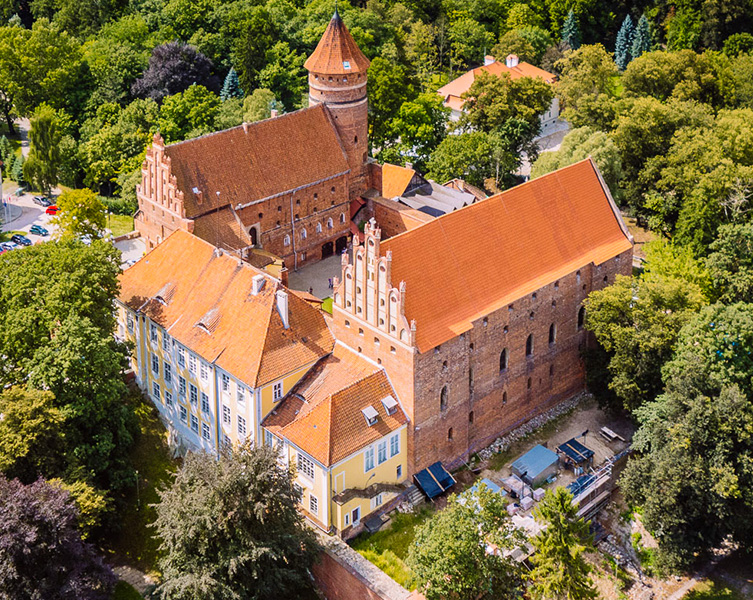
Fig. 10a. Castle Allenstein/Olsztyn (credit: mazury.travel)
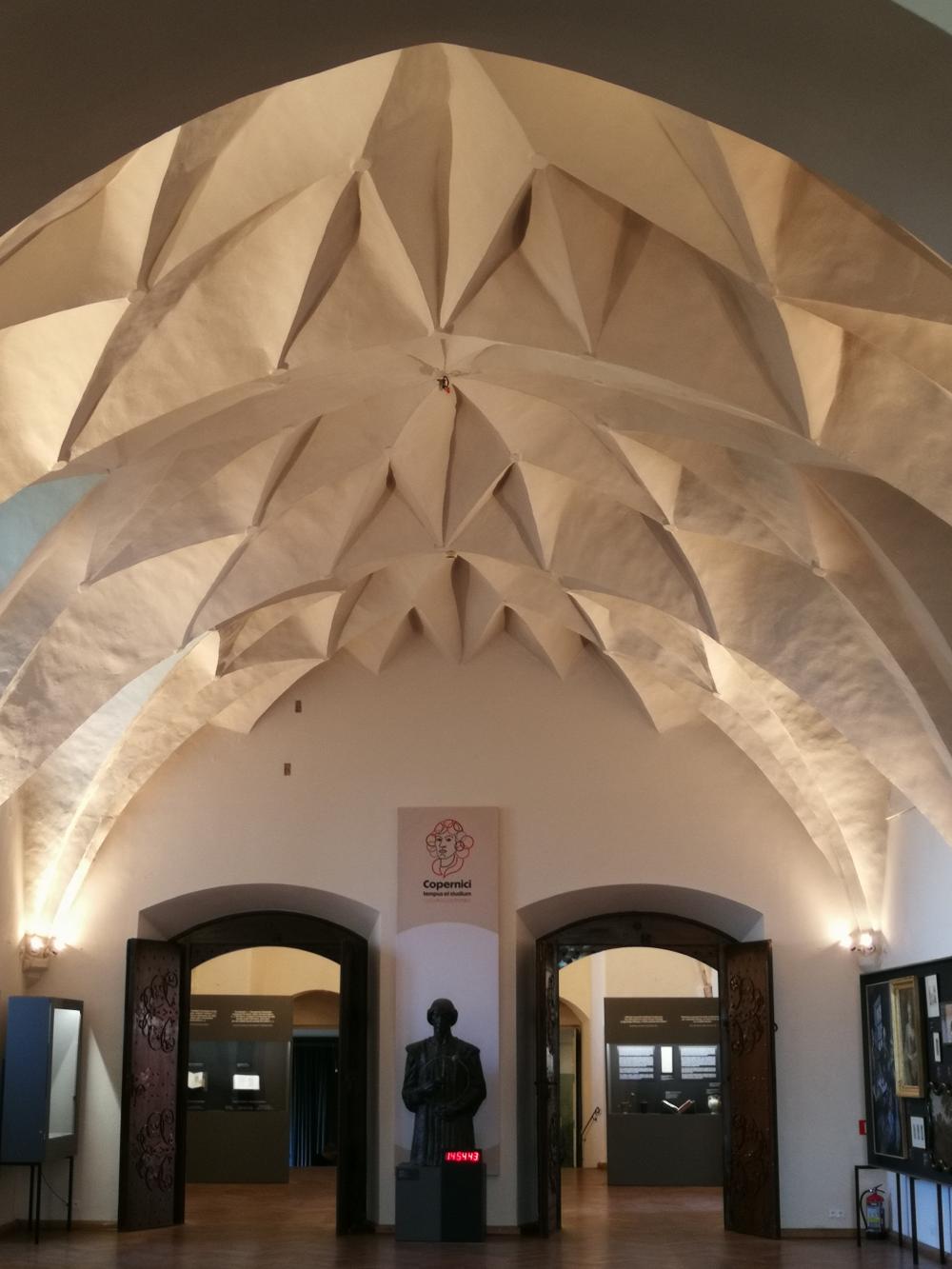
Fig. 10b. Diamond Vaults of the Gothic Hall in Castle Allenstein/Olsztyn (Photo: Gudrun Wolfschmidt)
Comparison with related/similar sites
This Heliograph, engraved in the wall, is a very important "astronomical instrument" -- a unique instrument, only comparable to a certain extent to the meridian lines in churches and observatories, where the building is the instrument, cf. meridian line in the Mathematical Tower in Breslau/Wrocław (1791).
Threats or potential threats
no threats
Present use
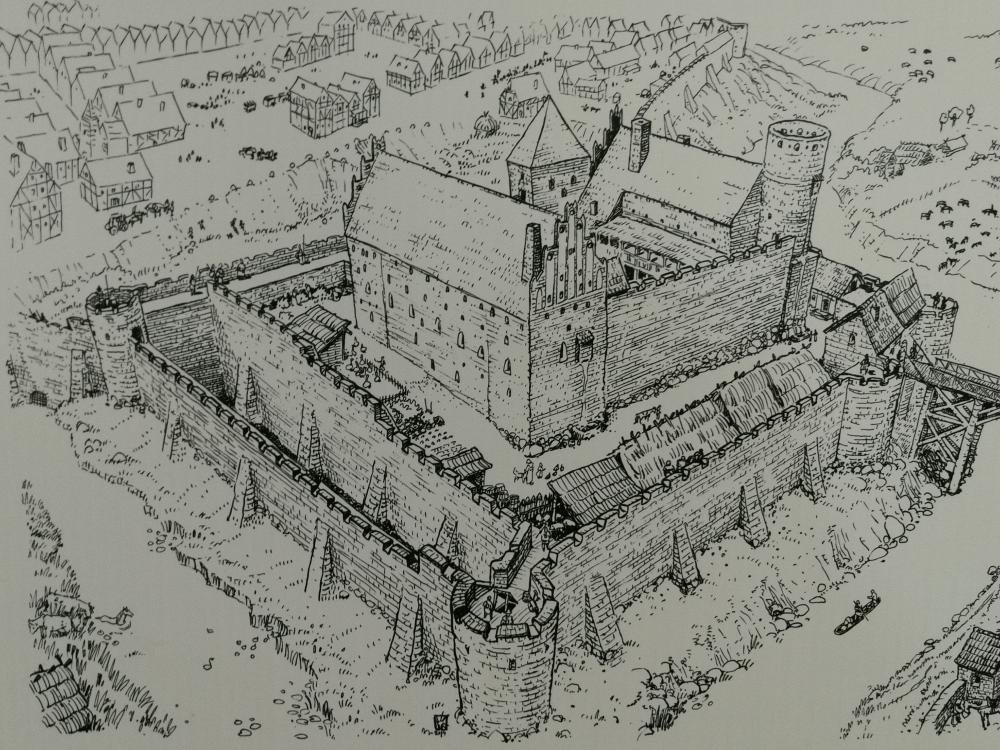
Fig. 11a. Layout of the fortified Castle Allenstein/Olsztyn in the Middle Ages with two towers (Photo: Gudrun Wolfschmidt)
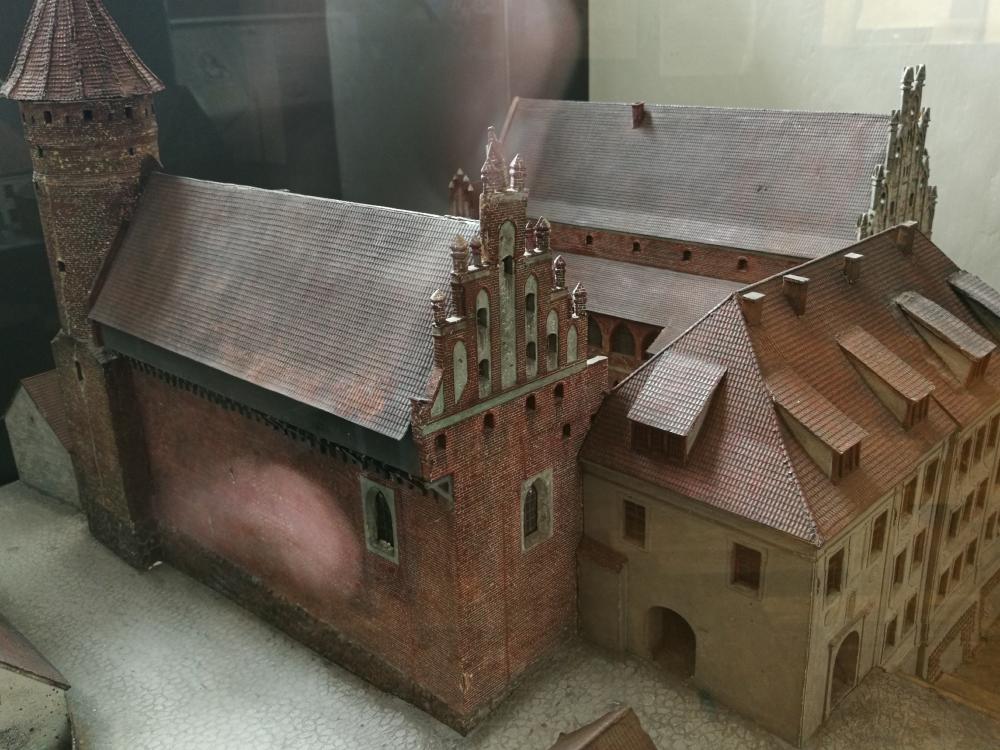
Fig. 11b. Model of Castle Allenstein/Olsztyn (Photo: Gudrun Wolfschmidt)
The Castle Olsztyn/Allenstein is today used as the Museum of Warmia and Masuria (founded in 1945). The Museum’s Library’s collections hold the medical incunabula of Copernicus.
The Museum is also a memorial place for Copernicus, showing his Heliograph, Experimental table of Nicolaus Copernicus and a permanent exhibition Nicolaus Copernicus, resident of the Olsztyn Castle.
An special Jubilee Exhibition (2023) -- 550th Birthday of Copernicus -- in the Museum of Warmia and Masuria shows Copernici tempus et studium. Czas i praca Kopernika -- Time and work of Copernicus. The leitmotiv of the exhibition is reflection on time and work, and its tangible dimension is Copernicus’ astronomical table. The Latin word studium (study) in the title of the exhibition means work done with passion, commitment and care.

Fig. 12. Copernici tempus et studium -- Time and work of Copernicus in Castle Allenstein/Olsztyn (Photo: Gudrun Wolfschmidt)
Astronomical relevance today
The Castle Olsztyn/Allenstein is no longer used for astronomy.
But there is a former water tower in Olsztyn, which has been adapted into a public observatory (Obserwatorium Astronomiczne), Żolnierska 13. In 1973, in the 500th Copernicus jubilee year, a Planetarium was opened in Olsztyn, Aleja Marszałka Józefa Piłsudskiego 38.
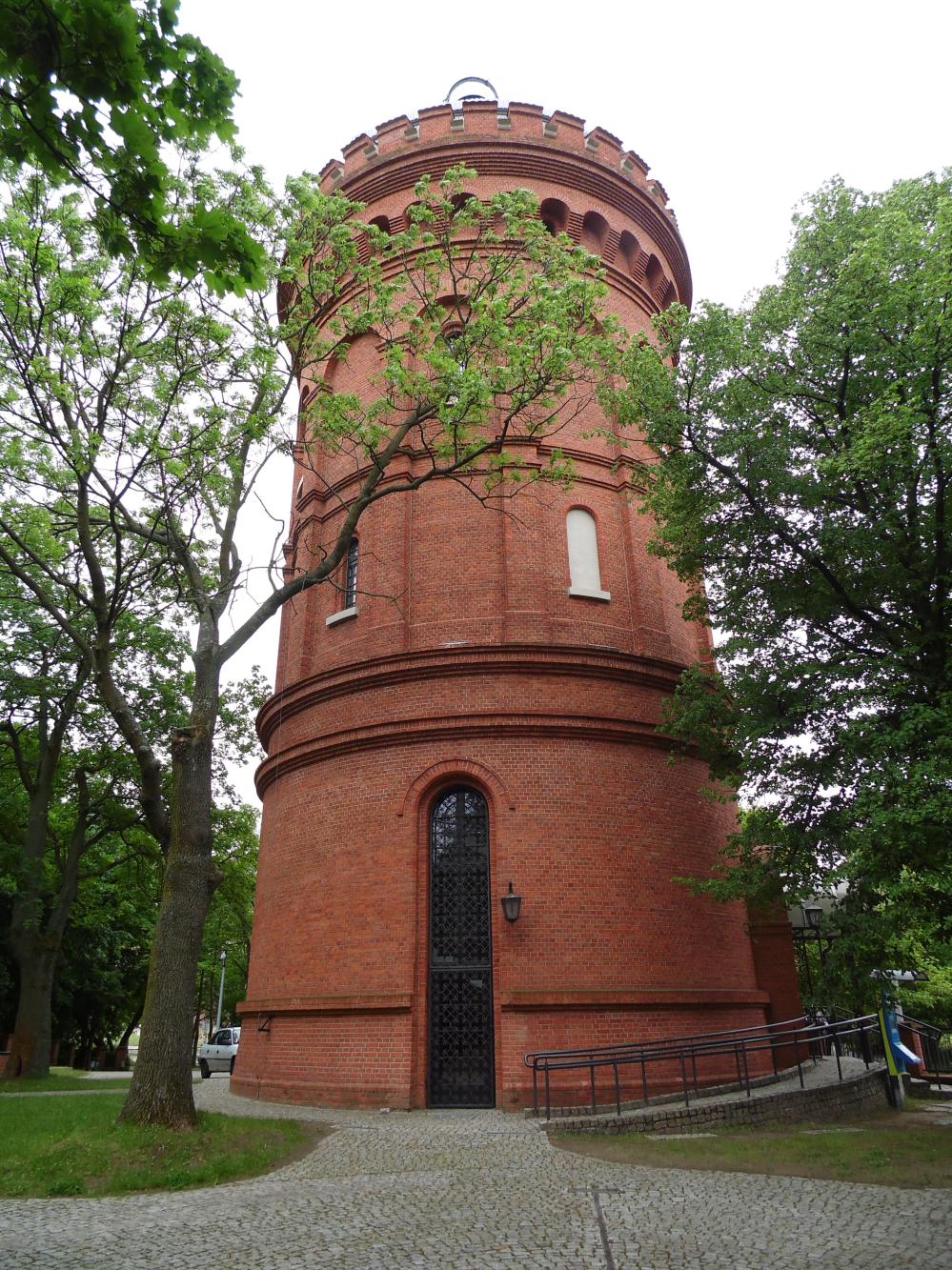
Fig. 13. Public Observatory in Olsztyn (CC4, Antekbojar)
References
Bibliography (books and published articles)
- Graßhoff, Gerd & Gordon Fischer: Copernicus’ Heliograph. Edition Topoi 2017,
DOI: 10.17171/2-7, (http://repository.edition-topoi.org/collection/COPS). - Landau, Elizabeth: Chasing Copernicus in Poland. In: Scientific American Blog Network (December 7, 2028), (https://blogs.scientificamerican.com/observations/chasing-copernicus-in-poland/)
- Langkavel, Arno: Über ein Copernicus-Denkmal, das es nicht mehr gibt. In: Beiträge zur Astrononmiegeschichte, Bd. 10. Frankfurt: Verlag Harri Deutsch (Acta Historica Astronomiae; Vol. 37) 2010, p. 326--331.
- Ritter, Elisabeth: Nikolaus Kopernikus. Über die nationalen Umschwünge im Lebenswerk des großen Astronomen. In: Hahn, Hans Henning & Robert Traba (Hg.): Deutsch-Polnische Erinnerungsorte. Paderborn 2019, p. 615--633.
- Rusinek, Michal: Land of Nicholas Copernicus. New York 1973.
- Szubiakowski, Jacek P. & Jarosław Włodarczyk: The Solar Dial in the Olsztyn Castle: Its Construction and Relation to Copernicus. In: Journal for the History of Astronomy 49 (2018), No. 2, p. 158--195.
- Volk, Wolfgang: Zeugnisse zu Mathematikern -- Monuments on Mathematicians.
(http://www.w-volk.de/museum/entry_de.htm). - Westman, Robert S.: The Copernican Question: Prognostication, Skepticism, and Celestial Order. Berkeley, Los Angeles, London: University of California Press 2011.
- Wójcik, Tadeusz P.: Reconstruction of Markings on Copernicus’ Table -- Linear Non-Meridial Declination of the Sun. Spatial Cybernetics 2004--2012. Based on Rosetec 1990--2017.
-
Wolfschmidt, Gudrun (ed.): Nicolaus Copernicus (1473--1543) -- Revolutionär wider Willen. Nicolaus Copernicus (1473--1543) -- Revolutionary against his Will. Begleitbuch/Katalog zur Ausstellung im Zeiss Großplanetarium in Berlin, Juli bis Oktober 1994. Stuttgart: Verlag für Geschichte der Naturwissenschaften und Technik 1994.
-
Wolfschmidt, Gudrun: Astro Walk in the footsteps of Copernicus and Kepler. In: Between Ancient and Modern Astronomy. Proceedings of the 30th SEAC, Polish Academy of Sciences, Warsaw, Poland, September 6-9, 2023. Ed. by Michal Giłewski. Warsaw 2024.
Links to external sites
- Olsztyn Castle
- Museum of Warmia and Masuria -- -- Animation of Copernicus' Heliocentric System
- Olsztyn Castle -- The Association of Castles and Museums around the Baltic Sea
- Experimental Table of Nicolaus Copernicus
- Copernici tempus et studium. Czas i praca Kopernika -- Time and work of Copernicus, Jubilee Exhibition in the Museum of Warmia and Masuria (21.3.--30.9.2023).
- Copernican medical incunabula
- Mazury.Travel -- Na szlaku z Kopernikiem -- miejsca, gdzie zyl i pracowal wiełki astronom.
This trail leads through unique places. It is nearly 300 km of an exciting journey in the footsteps of great discoveries that forever changed the perception of the universe. In Warmia, Copernicus spent 40 years of his life as a canon of the Warmia chapter, and regardless of that, he observed the sky, worked on the heliocentric theory and wrote down his work.
The Copernicus Trail in Warmia and Mazury leads through the cities of: Elbląg, Tolkmicko, Frombork, Braniewo, Pieniężno, Orneta, Lidzbark Warmiński, Dobre Miasto, Olsztyn, Olsztynek, Lubawa and Nowe Miasto Lubawskie. No matter where you start your journey, be ready for great discoveries. - Planetarium and Astronomical Observatory om Olsztyn
Links to external on-line pictures
no information available
No multimedia content published
Currently there is no multimedia content published for this case study











